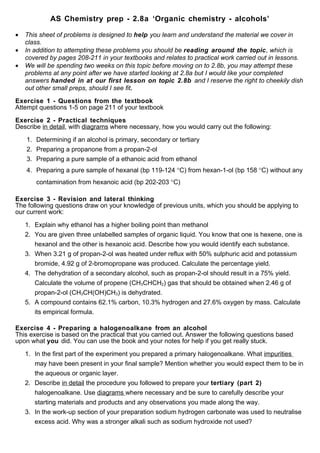
As Chemistry Prep 2 8ab Alcohols And Halogenoalkanes
- 1. AS Chemistry prep - 2.8a ‘Organic chemistry - alcohols’ • This sheet of problems is designed to help you learn and understand the material we cover in class. • In addition to attempting these problems you should be reading around the topic, which is covered by pages 208-211 in your textbooks and relates to practical work carried out in lessons. • We will be spending two weeks on this topic before moving on to 2.8b, you may attempt these problems at any point after we have started looking at 2.8a but I would like your completed answers handed in at our first lesson on topic 2.8b and I reserve the right to cheekily dish out other small preps, should I see fit. Exercise 1 - Questions from the textbook Attempt questions 1-5 on page 211 of your textbook Exercise 2 - Practical techniques Describe in detail, with diagrams where necessary, how you would carry out the following: 1. Determining if an alcohol is primary, secondary or tertiary 2. Preparing a propanone from a propan-2-ol 3. Preparing a pure sample of a ethanoic acid from ethanol 4. Preparing a pure sample of hexanal (bp 119-124 °C) from hexan-1-ol (bp 158 °C) without any contamination from hexanoic acid (bp 202-203 °C) Exercise 3 - Revision and lateral thinking The following questions draw on your knowledge of previous units, which you should be applying to our current work: 1. Explain why ethanol has a higher boiling point than methanol 2. You are given three unlabelled samples of organic liquid. You know that one is hexene, one is hexanol and the other is hexanoic acid. Describe how you would identify each substance. 3. When 3.21 g of propan-2-ol was heated under reflux with 50% sulphuric acid and potassium bromide, 4.92 g of 2-bromopropane was produced. Calculate the percentage yield. 4. The dehydration of a secondary alcohol, such as propan-2-ol should result in a 75% yield. Calculate the volume of propene (CH3CHCH2) gas that should be obtained when 2.46 g of propan-2-ol (CH3CH(OH)CH3) is dehydrated. 5. A compound contains 62.1% carbon, 10.3% hydrogen and 27.6% oxygen by mass. Calculate its empirical formula. Exercise 4 - Preparing a halogenoalkane from an alcohol This exercise is based on the practical that you carried out. Answer the following questions based upon what you did. You can use the book and your notes for help if you get really stuck. 1. In the first part of the experiment you prepared a primary halogenoalkane. What impurities may have been present in your final sample? Mention whether you would expect them to be in the aqueous or organic layer. 2. Describe in detail the procedure you followed to prepare your tertiary (part 2) halogenoalkane. Use diagrams where necessary and be sure to carefully describe your starting materials and products and any observations you made along the way. 3. In the work-up section of your preparation sodium hydrogen carbonate was used to neutralise excess acid. Why was a stronger alkali such as sodium hydroxide not used?
- 2. Remember you can always ask for help from EBG or myself, you can even email me mfe@slcuk.com MFE AS Chemistry prep - 2.8b ‘Organic chemistry - halogenoalkanes’ • This sheet of problems is designed to help you learn and understand the material we cover in class. • In addition to attempting these problems you should be reading around the topic, which is covered by pages 208-211 in your textbooks and relates to practical work carried out in lessons. • We will be spending two weeks on this topic before moving on to 2.9, you may attempt these problems at any point after we have started looking at 2.8b but I would like your completed answers handed in at our first lesson on topic 2.9 and I reserve the right to cheekily dish out other small preps, should I see fit. Exercise 1 - Uses of halogenoalkanes We covered uses of halogenoalkanes briefly in class. Now is your chance to find out about them in more detail:
- 3. 1. List and explain as many (at least 5) applications of halogenoalkanes as you can. 2. Which properties of many halogenoalkanes make them attractive for commercial use? 3. What are CFCs and how can they be problematic? 4. What alternatives to CFCs are there and how can they also be problematic? Exercise 2 - Reactions of halogenoalkanes This exercise includes questions about the reactions of halogenoalkanes, practical techniques and some revision/lateral thinking questions: 1. Describe and explain a test to determine whether a halogenoalkane is primary, secondary or tertiary. 2. Explain why 2-iodopropane is hydrolysed by sodium hydroxide at a faster rate than 2- chloropropane. 3. A chloroalkane contains 37.2% carbon and 55.0% chlorine by mass. Calculate its empirical formula. 4. Draw out a spider diagram to show the possible reactions, reaction conditions and products of the reactions of halogenoalkanes. 5. Draw a similar spider diagram for the reactions of alcohols. Exercise 3 - Questions from the textbook Answer questions 1-4 on page 219 of your textbook. Remember you can always ask for help from EBG or myself, you can even email me mfe@slcuk.com MFE